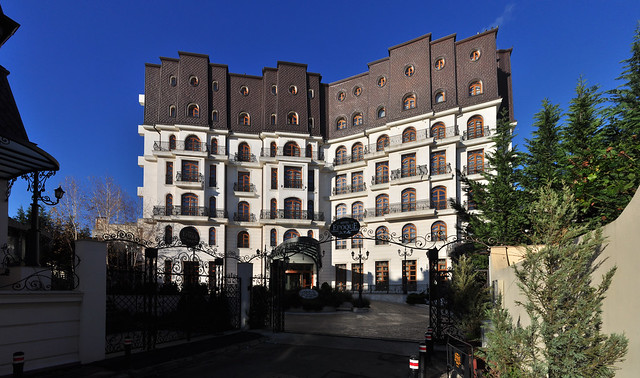
So once again I find myself in Bucharest. The short version of how I come to be here: about 3 years ago I connected some people and the result has been a software development firm out near Piața Victoriei that currently employs 11 people. They invited me over for a weekend to attend their Christmas party; having made the journey, I decided I'd stay on a week at my own expense as a tourist. So, for the first time ever I have a week in Bucharest with no actual work obligations.
I've been taking a ton of photos and uploading them; you can see them on my Flickr account.
Several of my colleagues here have asked me for my impressions of what has changed in the last 8 years. This has been mostly a trip to central Bucharest, not a trip to Romania in a broader sense, so I could be missing a lot, but in no small degree I can reiterate much of what I wrote in 2006 about changes since 2002. The general direction of the country seems to be a good one. For the first time ever, it is likely that dishonest officials have more to fear from honest journalists than vice versa, and while those honest journalists may have trouble getting their opinions into print, these days there is the web. There is perhaps a trace less optimism than in 2006 (when the country was on the verge of EU membership) but the replacement is not so much pessimism as a certain cynicism tempered by a great deal of humor.

|
| Hotel Epoque |
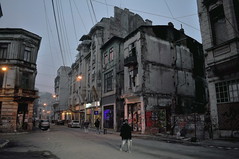
|
|
Around dawn in Str. Blănari, in the Old Town (Lipscani). |
The air in the city continues to get cleaner: I'd say it's up to normal European urban standards by now. The leu has continued to hold its value pretty well against the dollar, though not so much against the euro. It's done better than the Japanese yen over the last eight years. Gentrification continues apace; many of the changes are good, some are not. Street hassle is down to a level comparable to Seattle (where I live), maybe lower. The Lipscani neighborhood in the old city is now a dining/nightlife area almost any city would be glad to have; everyone but old-timers now calls it "Old Town", using the English. Nearly everyone under 40 and many older than that seem to speak at least to some English. Lipscani is not quite the Leidseplein or Brick Lane, but it will do. This is now a city I could recommend to any tourist who isn't downright timid; twelve years ago, it was not a tourist destination for anyone but the intrepid, and it was still considered a bit of a hardship post for business or diplomatic travelers. Now, that's hard to imagine. If you have money, you can get things done here. The Athéneé Palace Hilton, where I'm staying right now, is no longer at all clearly the best hotel in town: in particular, the rooms at the Hotel Epoque where we had our Christmas party have a lot more character and it is certainly equally luxe, if not more so. Either costs considerably less to stay at than the Hilton used to, because there is far more competition.
Perhaps the biggest positive: few of the historic buildings look neglected, whereas even as recently as 2006, most did. You can see again how this was once "the Paris of the Balkans." You can see it even without squinting. Some restoration projects (especially on churches) do seem to be taking forever: I was joking that in a few more years, the scaffolding around some of them will qualify in its own right as a Monument Istoric. Second biggest: there are now a lot of good places to eat, up and down the cost spectrum, and for the most part the people working in them (and in the stores) have learned how to deal with their customers in a manner that is neither hostile nor overly servile. At the same time, the street food, while no longer as insanely cheap in world terms as it was before, remains an amazing bargain: you could stuff yourself on a take-out meal including beverage for about $US3. Also, and I don't know how much this reflects any other time of the year, the Christmas markets, which used to be a bit sad, are now really fun, again something any city would be happy to have. Oh, and maybe third: taxis are still cheap, still efficient, and far more reliably honest than they used to be. And most of the drivers have learned at least a modicum of English.
The negatives: probably still at least as tough place as before to be poor, maybe tougher than before because of fewer neglected niches in which one can get by. Less and less opportunity to just grab an unused space and do something quirky and interesting. A bit less local character, partly due to the arrival of more international brands, but also due to some insensitive urban planning: the rebuilt Amzei Market is bland, where its rundown predecessor felt like the beating heart of a community; Gradina Cismigiu on a winter night is still a great place, but no longer feels like something out of a Breughel painting, just a good park in a nice, mostly modern city.
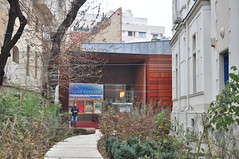
|
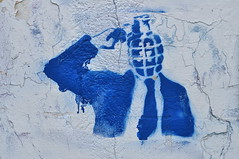
|
|
Sala Elvira Popesco, cinema at the French cultural center |
Graffiti in Str. Arthur Verona |
In between: the arts are still thriving. More theaters, more galleries. From what I've seen, theater standards here remain as high as any city where I've ever spent much time (which includes New York and London); visual arts maybe a bit less so: there's more space to see stuff, but not necessarily more art really worth seeing. (I haven't been here long enough to say what's going on in music.) In international terms, nothing in the arts is quite the crazy bargain it was, but everything is still inexpensive by Western standards. Oh, and the graffiti has gotten better.
Also in between: the bureaucracy is still rather remarkably inefficient, though rarely malicious.
More personally: great to see old friends again and maybe make a few new ones. I'm going to skip naming them here, since I might offend either by excluding someone or naming people who'd rather not be named, but besides numerous ex-colleagues, Bucharest remains a city with few enough tourists that if you are actually interested in things here, people will be interested that you are interested, and conversations are easy to start (if occasionally hard to finish).
The Hotel Epoque, where we had the Christmas party and where I stayed for two nights, is an absolute gem, an almost palatial boutique five-star hotel at the end of a quiet dead-end street just west of Gradina Cismigiu. For anyone with the money and who does not need to be in the absolute center of everything (and only a kilometre out, at that), I would absolutely recommend it; it's almost like staying at a spa hotel, and it's almost in the heart of the city.
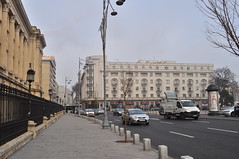
|
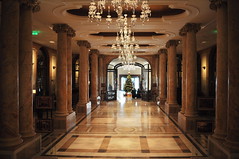
|
|
At left, the former royal palace, now an art museum. At right, the Athéneé Palace Hilton.
|
Lobby of the Athéneé Palace Hilton.
|
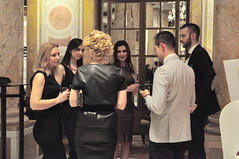
|
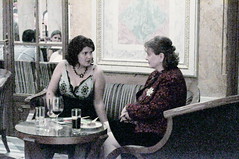
|
| In the the Athéneé Palace lobby, people far more beautiful than I. | |
The Athéneé Palace Hilton, where I am now, is the city's most famous hotel. Its lobby remains as much of a nexus as any one place in town, and facilities like the pool and health club are excellent (ditto on that last for Hotel Epoque), but my room is just a run-of-the-mill good hotel room: certainly more luxurious and with far better art on the walls than, say, a Holiday Inn, but not really with any more character. It's not a place anyone would want to live for a month or more, just a good way to stay in a city for a week.
The mostly young staff at the Epoque are clearly trying hard to become the city's leading hotel, and it feels like every member of the team, and "team" definitely the word, really cares. At the Hilton, most of the staff are quietly professional, but don't seem driven. Conversely, a few "stars" at the Hilton bring something that Epoque presumably won't be able to match for years. Daniela, the daytime floor manager at the restaurant, started out 15 years ago as a very young waitress, and is a gem on all counts, but the real star is Vasile the chief concierge. I can't imagine how many hours he must work, and I gather that even a good part of his supposed leisure time is spent keeping up with everything happening in Bucharest so that he will know what current play is a must-see, which art exhibit will meet whose tastes, what public building is undergoing repairs, which restaurant recently changed chefs, etc. He apparently has a background in electrical engineering, then worked for a while for Romanian Customs where his aptitude for languages got him involved in the process of getting the country's customs processes in line with those elsewhere in Europe. In 1997 he saw an opening at the Athéneé Palace Hilton, leapt at the opportunity, and wowed them with his language and computer skills (this before the country's tech boom). Although he is only in his forties, he seems like a figure out of the Athéneé Palace's heyday in the 1920s and '30s.
While I'm at it: breakfast at both hotels is world class, but at the Hilton it is still a cut above: amazing things like truly great tomatoes in December (where, where, where did the get them?), gourmet cheeses, sausages that look like works of art, smoked whitefish that Zabar's would be proud of. Epoque's breakfast is close, and their espresso is better. (N.B. I only ate the Hilton breakfast once, because I my room was "European plan" and I'm not routinely in the habit of paying $17.50 for breakfast, but I'll admit it is worth every penny of that, if not more.)
My main way of recovering my Romanian language skills has been to go to the theater. A lot of that has been like renewing old acquaintances as well: I saw Maia Morgenstern in a revue of old Yiddish Theater material (songs in Yiddish, the rest in Romanian) and Marcel Iures in an intimate 2-man show at Teatrul ACT.
I went to one museum I'd never been to before: Muzeul Colecțiilor de Arta (the "Museum of Art Collections"), closed last time I was here, is now the city's second most important art museum after the national gallery in the old royal palace. Besides great collections of artists I already knew well, such as Corneliu Baba and Theodor Pallady, it also introduced me to a bunch of excellent mostly 20th century artists I didn't know or barely knew. In roughly descending order of interest (though even the bottom here is high), Iosef Iser, Max W. Arnold, Albert Dov Sigal, Lucia Dem. Bălăcescu, Idel Ienchelovici, Marcel Iancu, Nicolae Tonitza. The museum is well put together, but a bit odd. I gather its name comes from the fact that it began in the Communist era with some not-so-voluntarily-donated collections. There was about a 3-1 ratio of museum guards to museum-goers. The woman at the front desk was knowledgeable, helpful, fluent in English, and very cynical in a particularly Romanian way. We had a pleasant chat, because we both have dark senses of humor.
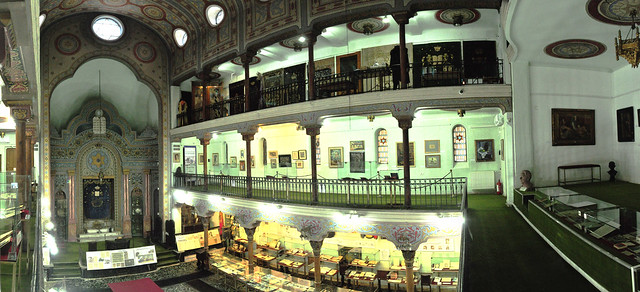
|
| Interior of the Jewish Museum |
I also went to the Jewish Museum (properly something more like "Museum of the History of Jews in Romania"), which has recently expanded the area in which it displays peices from its excellent art collection (mostly, though not exclusively, either Romanian Jewish artists, or non-Jewish Romanian artists painting Jewish subjects). The current art exhibit was a bit over half women artists, which I think is great, especially because they didn't make a big deal of it, just did it. One artist whose work I didn't know but will want to look into is Tia Peltz, who died in 1999 and according to someone at the museum also has a couple of pieces in the Romanian National Art Museum (in the former royal palace). (On a practical note: if you ever go to visit the Jewish Museum, bring a passport; for security reasons, you need either a passport or Romanian identity papers to enter.)
I've set up a separate gallery of photos from the Jewish Museum. None of the paintings, I'm afraid, that's the one thing people are not welcome to photograph there.
One evening in Calea Victoriei I saw a woman in peasant dress carrying a lamb, and smoking a cigarette. There is no imaginable American equivalent, though after some discussion on FaceBook I've sort of constructed a model in American terms. Start with Fifth Avenue in New York City just downtown from Central Park (Plaza Hotel, Bonwit Teller, Rockefeller Center, etc.). Add a few actual palaces, but also add a few buildings that look like they belong in a nondescript part of Queens. Now imagine that there is an equivalent of the Amish who nonetheless smoke cigarettes and that one of them is walking down the street carrying a lamb as if it were the most normal thing in the world.
At the gallery Simeza in B-dul Magheru, I managed to meet both the gallerist, a woman named Ena who is close to my age and hence studied French, not English (not the easiest of conversations, but we managed) and an art critic from Obeservator Cultural, who spoke quite decent English, and who is apparently just now completing teaching a one-semester pilot course at the university here on the the intersection of sculpture and time (e.g. sound sculpture); unpaid this first time, but he said he had 35 students and the class went well, so he has hopes of it becoming an established, paid lectureship.
My only other good story involves crashing a party. If you know me, feel free to ask when you see me, but I'm not publishing that one.
Pe curind.
"Copyleft": With appropriate notification and appropriate credit, non-commercial reproduction is welcome: contact me if you have any desire to reproduce these materials in whole or in part.
My e-mail address is [email protected]. Normally, I check this at least every 48 hours, more often during the working week.